
Follow this link for the fourth in a series of essays in honor of André Bazin . . .


Follow this link for the fourth in a series of essays in honor of André Bazin . . .

The fourth in a series of essays in honor of André Bazin . . .
André
Bazin was exhilarated by the idea of a cinema grounded in photographic
images that conjured up an intense illusion of space. He saw this
as the center of cinema's power. Montage, he believed, created
only secondary and less powerful effects, merely intellectual and
therefore not as profound. Cutting between shots of a single
location could create a mental impression of the space of the location
but not a visceral sense of experiencing that space first-hand.
“Metaphorical montage”, cutting between images to create a conceptual
relationship between them — as between a shot of a kiss and a shot of
fireworks going off — he saw as equally “intellectual” and thus
equally secondary. Cutting, he believed, tended to undermine the
power of cinema to imaginatively, as opposed to rationally, engage us.
He was on to a signal truth here, but there are some problems with his
argument. He consistently identified cinema's spatial illusion
with realism, and saw that realism, the shared ontological identity of
an actual space and its photographic record, as crucial to cinema's
power. However, as I've argued before, this fails to account for
the cinematic power of hand-drawn or computer-generated images, both of
which can create impressions of spaces which can engage us
imaginatively just as powerfully as photographic images.
Consider also the realm of dreams. We often in dreams enter
spaces which have no correlative in the waking world — a new wing of
our house, for example, which seems just as real as the house we know
in waking life. The impression of “reality” here does not depend
on any shared ontological identity between the imaginary wing and our
dream experience of it. The mechanical authority of the camera
does not figure into the equation, and yet the imaginary wing feels
just as real as the spaces of waking reality. Our dreaming mind
convinces us of this reality without any forensic corroboration.
It is the impression of space alone which links photographed cinema
with animated cinema. Photography and animation are merely
techniques for creating illusions of space which we can imaginatively
enter as wholly and as confidently as we enter the spaces of dreams.
Bazin argues that shots need to convey a sufficient impression of
“realism” to counteract the enervating tendency of montage, which
again is a profound insight, but fails to account fully for the dual
nature of some “metaphorical” editing. When Hitchcock cuts from a
shot of Cary Grant and Eve Marie Saint embracing on the train at the
end of North By Northwest to
a shot of the train entering a tunnel, the intellectual aspect of the
visual pun is clear enough — but both shots are interesting and
powerful plastically, both deliver a visceral impact, so that we can
not only comprehend the meaning of the shot of the train rationally
(as a pun) but also feel it as a physical evocation of intercourse.
Finally, Bazin's evaluation of montage does not fully take into account
the musical effects which editing can create. I would agree with
Bazin that such effects only have true power when the images involved
have an intrinsic plastic power of their own. We have all seen
those “experimental films” in which indifferent images are cut to the
rhythms of a piece of music — their effect is thin, superficial, the
correspondences between the rhythms of the music and the rhythms of the
editing merely mechanical, an exercise in redundancy.
But consider the musical rhythms of the editing in Orson Welles' Falstaff.
The images, however fleeting, are always powerful plastically,
viscerally evoking space, but the editing gives them a new musical
quality — much the way the rhythms of poetic meter confer a
meta-meaning above and beyond the literal meaning of the poet's words.
My arguments with Bazin here are narrow but important, I believe.
If I were speaking with him today, face to face, as I sometimes feel I
actually am, so vivid is his presence in his writing, I would urge him
to cut loose from his attachment to photographic “realism” and
concentrate on the imaginative uses of all illusory space in cinema,
however it's achieved, and to think again about the ways illusory space
can be enlisted in the service of montage, not just as a kind of
compensation for the intellectual reductionism of montage but as a way
of investing montage with an über-cinematic artistic capacity all its
own.
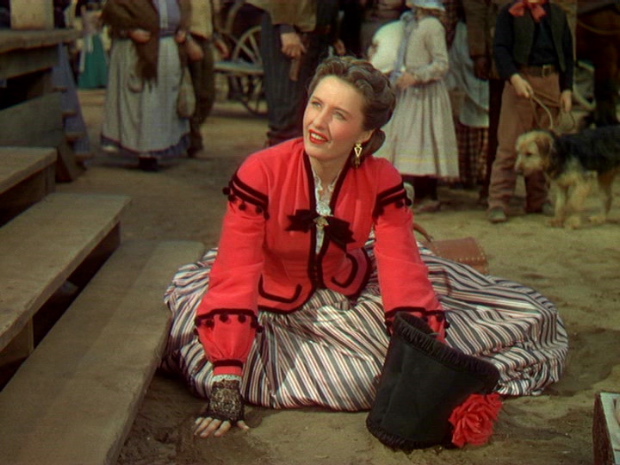
John
Farrow wasn't by any means a great director but he was a very
interesting man and he made some very interesting movies. A devoted
Catholic and a serious student of Catholicism — he wrote a book about
the history of the Popes — he was also known as a mean son-of-a-bitch
on the set who liked to bully his actors and crew. After shooting
wrapped on California (above), star Barbara Stanwyck demanded that he make a public apology to everyone who worked on the production.
On the other hand, she gives a terrific performance in California,
way better than the mediocre script deserves, and the film is filled
with surprising passages, notably a number of extremely long and
complicated scenes played out in single takes with extensive camera
moves. None of these, however, is framed or choreographed
dynamically, so they don't have the excitement of the long takes found
in the films of Welles or Renoir.
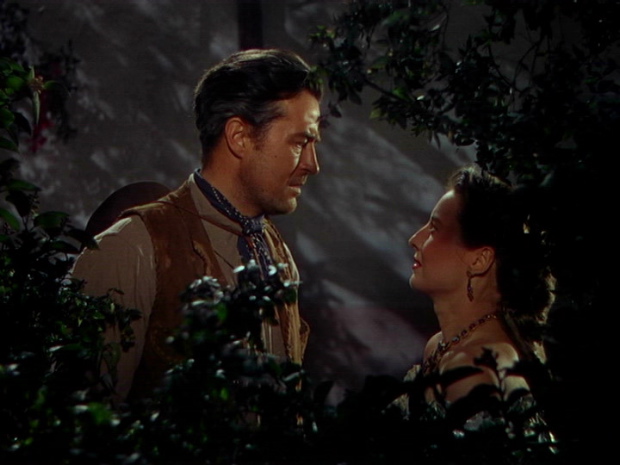
California doesn't have a
coherent tone in any respect. It has odd, grandiose montages with
opera-like chorales playing under them, and conventional Western
musical interludes in which characters sing improbably. The
gritty, sexy frontier hustler created by Stanwyck seems to be from
another movie.
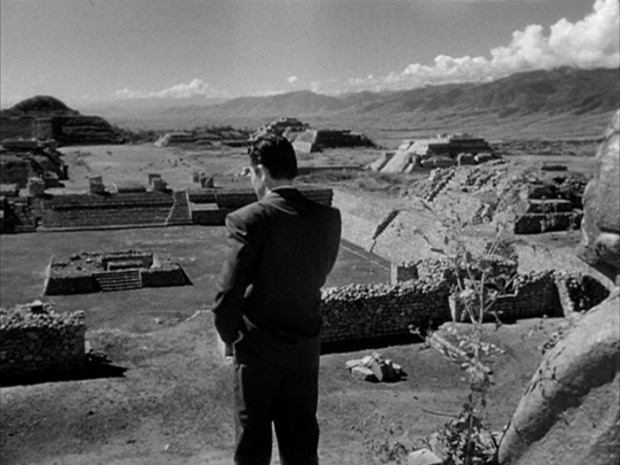
Farrow didn't seem to have a good feel for genre or for script. Plunder Of the Sun (above), filmed entirely, and very evocatively, on location in Mexico has one of the most stylish and promising film noir
openings ever concocted, but the story just dribbles away, turns into a
conventional treasure-quest adventure. Again, a superb central
performance — this time by Glenn Ford, tense with understated despair
— is wasted.
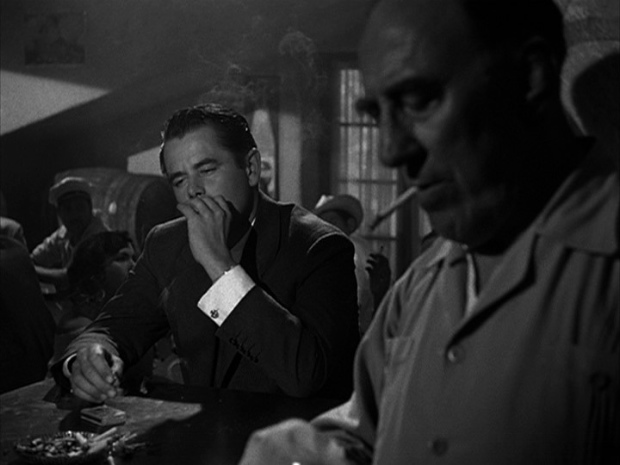
Still, there's usually something in a John Farrow movie worth paying
close attention to — some flight of inspiration that redeems the
clunkiest programmer. He had a kind of ambition, a kind of
vision, but it seems to have come to him in fits and starts.
Maybe the frustration of that was the source of his on-set rages.
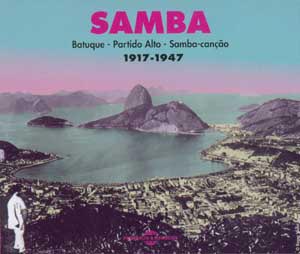
In a previous post about Orson Welles's ill-fated Brazilian film It's All True
I mentioned that Welles came to see the history of the samba as the key
to Brazilian culture. I wondered if there might be a CD
collection that showcased that history. Of course there was, and
of course it was French — the French having a knack for combining
passion about American music with a logical approach to presenting it.
Fremeaux & Associates offers several historical surveys of
Brazilian music which give a good idea of what Welles found when he
visited the country in 1942. The one above surveys the samba
alone, which originated around 1917 as music for the Carnival and
eventually became a highly commercialized form of dance music
throughout the Americas in the 1940s.
The great revelation of this set is Carmen Miranda in her pre-Hollywood
days. Before she became a musical comedy star, famous for her
tall fruit-basket hats (“Bananas is my business!”), she was one of the
musical treasures of Rio — a terrific and very sexy singer.
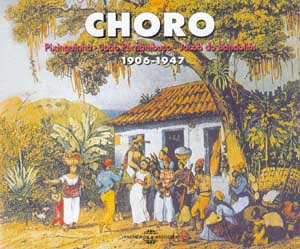
But samba, as it turns out, is just the rio
into which all streams of Brazilian music flow. The oldest style
it incorporates is choro, an instrumental form meant for listening, not
dancing. It usually features ornate flute lines accompanied by
various stringed instruments. It started out very European in
sound, with African rhythms adding flavor, but later became a bit more
rambunctious. Its evolutions are charted in the collection
illustrated above.
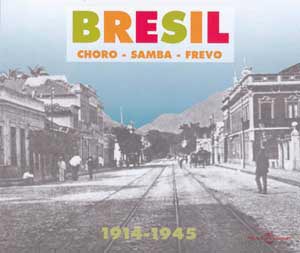
Other subsets include brass marching-band compositions and various
regional styles, many of which are charted in the Fremeaux
&
Associates collection above. Fremeaux offers a couple of other
historical surveys, but these three will give you a comprehensive
picture of Brazilian music in the first half of the 20th Century.
The pleasures they deliver are not primarily scholarly, however.
There's hardly a song on any of the two-disc sets which is less than marvelous, and all of them
will set you either dreaming or dancing. (The imported sets can
be found on Amazon, most cheaply through their Amazon Marketplace
sellers.)
Listening to these CDs you'll see right away what so enchanted Welles
back in 1942 and grieve anew that he never got a chance to finish his
film about Brazil and the samba.